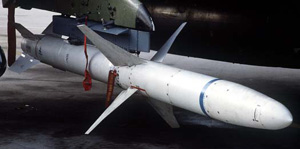
Ran in The Weaponeer on 21 January 1999
Major milestones surround HARM's recent live-fire tests
By Cdr. Steve Burris
F/A-18 IPT Deputy

|
|---|
| Beyond demonstrating several new features offered aircrews in the 13E Operational Flight Program, a recent live-fire test demonstrated the Navy's latest missile software. |
China Lake, CA-While most members of the Weapons Division were just waking up during the first week of December, members of the High-speed Anti-radiation Missile (HARM) and F/A-18/F-2 test teams were hard at work with final preparations for a Dec. 3 live-missile firing. The firing represented the culmination of several diverse and significant accomplishments by members throughout all of the Naval Aviation Systems Team.
As the E/F program nears the end of its development phase, the F/A-18 Advanced Weapons Laboratory is completing the validation phase of aircraft computer and software checkout. As part of the overall integrated test team, the engineers, maintainers and aircrew assigned to F-2 have structured several difficult, realistic and demanding "live fires" to assess E/F final readiness for supporting its operational evaluation conducted by Air Test and Evaluation Squadron Nine (VX-9).
The first of these live-fire events was conducted flawlessly over the China Lake land ranges. When first approached by the F-2 test team a few months ago to consider the possibility of conducting a dual missile shot, a test management team headed up by Steve Mendenhal and Claudia Theis immediately set their team to task on scenario support.
Knowing this would be the first attempt at the Lake to support a dual missile firing from a single launch platform, HARM Test Manager Roger Moorehead worked with Air Ops and range safety personnel developing a very robust tracking and monitoring plan. Watching the safe and successful launch of two missiles only seconds apart, Mendenhall, head of the Test Management Branch, said "This is another example of a professional test team, the range and the F/A-18 IPT, working together to meet the technical challenges involved in the testing of the Navy's newest aircraft, including safely conducting tests that are designed to be as tactically representative as possible."
As to why the test team sought the dual firing in the first place, Lt. Pete Matisoo (one of three F-2 test pilots) commented, "Our aim was to highlight as many new strengths as possible that E/F offers the air defense suppression role for Navy TACAIR."
Beyond demonstrating several new features offered aircrews in the 13E Operational Flight Program, this live-fire test demonstrated the Navy's latest missile software in the form of HARM Block 3A and Block 5. The Block 3A missile guidance software was designed, developed and tested by a small, but very effective government team within Thompson Laboratory at China Lake. "Our team has done a magnificent job," said Larry Luxton, of the HARM Program Office. "This firing was the fifth shot in what has been an extremely successful firing effort to prove out the Block 3A software. No software changes have been required to correct problems since commencement of the firing program. The team got it right the first time."
Using the AGM-88B missile guidance section, the Thompson Lab team significantly expanded HARM's capability for all F/A-18, EA-6B and F-16 forces with the completion of the Block 3A program. Commenting on four additional successful firings, also supported by the development team, Luxton said, "The Block 5 missile was the result of Raytheon's efforts in enhancing the guidance logic in the AGM-88C missiles that will also support Navy, Marine and Air Force units the world over."
Luxton explained that following several years of combined test planning efforts, involving a wide range of participants, the shot also demonstrated today's spirit of efficient and cost effective system validation. "In a single range event," he said, "the team managed to conduct tactics validation of new capabilities using the recommendations of instructors from the Naval Strike Air Warfare Center at Fallon."
Additionally, the missile firings encompassed test points needed to complete a combined test plan. These test points were developed following nearly two years of planning among aircrew and engineers within the Weapons and Aircraft divisions and VX-9.
Achieving all of this, while successfully ushering F-2 through its key milestones, has become the hallmark of the current NAVAIR test and evaluation community, said Charles Bechtel, E/F lead at China Lake. "The E/F program looks forward to many more similar events to come in the months ahead prior to commencing OPEVAL."
For more information on this test, please see the Dec. 10, 1998 issue of The Rocketeer.
-END-


